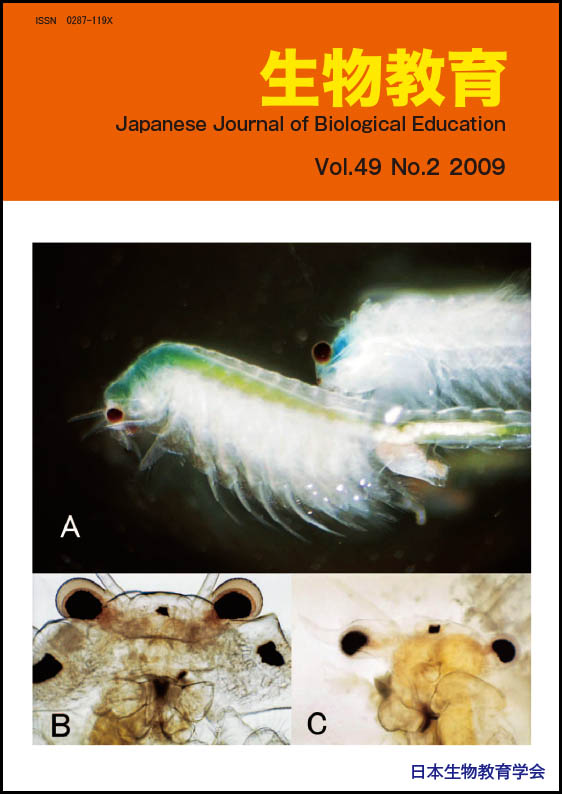
- Issue 2 Pages 68-
- Issue 1 Pages 1-
- |<
- <
- 1
- >
- >|
-
S. Irie, M. Watanabe2009 Volume 49 Issue 2 Pages 68-75
Published: 2009
Released on J-STAGE: September 28, 2019
JOURNAL FREE ACCESSFor high school students, evolution of animal behavior seems to be the most difficult concept to understand due to unavailable examples off ered by text books. In the present study, we developed teaching materials for the evolution of animal behavior and proposed the methodology. In the Japanese sulfur butterfl y Colias erate, polyandrous alba females are the dominant morph in the female population, though mated females do not easily re-accept males courting. The wings of mated alba captured in the field were closed by glue, and they were tethered in the grassland where males were searching for mates. We observed 1,830 entries of males into the imaginary hemisphere of 1 m radius around each female. A half of the males noticed and visited our females. Due to the closed wings, every female was unable to show the mate refusal posture, so the males continued their courtship behavior. However, the duration of hovering around the females was short in the morning, and most males left the females without touching them. Because newly emerged females promptly accept copulation with males in the early morning, males might prefer virgin females to mated ones. On the other hand, males that visited the females around noon prolonged the duration of hovering and tried to copulate persistently. The adaptive significance on the behavioral sequence was easily observed due to the closing femalesʼ wings. Manipulation of the butterfl y wings in the field observation was discussed in the viewpoint of the teaching materials for high school education on evolutionary biology.
View full abstractDownload PDF (547K) -
N. Kamata2009 Volume 49 Issue 2 Pages 76-81
Published: 2009
Released on J-STAGE: September 28, 2019
JOURNAL FREE ACCESSIt is important for students to study the skeletal structure for understanding morphology, function, classification and development of vertebrate. However, almost all junior high schools have few skeletal specimens and there are few guides to make them for junior high school teachers. In this study, I tried to show the effective methods to make the skeletal specimens. Animals were classified into three groups of “small” (less than 500 g body weight), “medium” (between 500 g and 1.0 kg) and “large” (more than 1.0 kg) for convenience. The protease method (PM) and the detergent for pipe drainage method (DPDM) were applied to each group. Although PM was able to remove soft tissues within a short period (2-9 hours) in “large”, the bones tended to be deteriorated. It should be noted that the preparation of specimens with PM was difficult in “small”. However, ultimately, soft tissue could not be completely removed from “small” and “large” with DPDM. In consequence, it was suggested that PM was useful for “large”, whereas DPDM was suitable for “small”. For “medium”, the parallel method, in which the vertebral and extremities parts were treated with PM, and the costal and foot parts were treated with DPDM, was suitable.
View full abstractDownload PDF (361K) -
Y. Matsumori, T. Tamura, A. Hachuda2009 Volume 49 Issue 2 Pages 82-89
Published: 2009
Released on J-STAGE: September 28, 2019
JOURNAL FREE ACCESSThe purposes of this study are 1) to examine whether preservice elementary and lower-secondary school teachers have familiarity with using photographs of 16 kinds of wild weeds and grasses using their photographs in a lower-secondary school science textbook; 2) to investigate whether they know the names of the wild grasses shown in the textbook. The fi ndings of this study were as follows: 1) less than 50% of the teachers had seen fi ve out of 16 kinds of the wild grasses; 2) less than 50% of them had touched nine out of 16 kinds of the grasses; 3)none of the teachers correctly wrote the names of the all kinds of grasses; and 4) none of them correctly wrote the names of five out of 16 kinds of the grasses. The authors suggested some teaching strategies to improve the problems mentioned above.
View full abstractDownload PDF (1261K)
-
Y. Sasakawa, Y. Sassa, M. Oto, M. Ono2009 Volume 49 Issue 2 Pages 90-107
Published: 2009
Released on J-STAGE: September 28, 2019
JOURNAL FREE ACCESSIt is thought that the experiments on human genome/gene analysis with PCR, elecrophoresis and so on, for educational purposes using studentsʼ own genome in schools are good for attracting their interests, studying about the essence of human genome, and thinking about the concerned problem themselves. But these kinds of experiments need expensive reagents and instruments, the teachersʼ deep knowledge and experience of molecular biology experiments. So it is not easy to become popular in schools. On the other hand, there are many teachers who want to do these experiments but feel uneasy about bioethics and the control of personal genetic information because there are no guidelines of the human genome/gene analysis for education. To make a suitable environment where teachers can do the experiments more easily, we investigated what was needed to it. We concluded that setting guidelines similar to DNA transformation experiments is needed for education. Therefore, we propose human genome/gene analysis guidelines for education, especially at high school, with consideration of bioethical issues, social issues, including control of genomic information, and experimental consideration for teachers.
View full abstractDownload PDF (450K)
- |<
- <
- 1
- >
- >|